Leadership and Management in Organizations: A Comprehensive Report
VerifiedAdded on 2022/12/09
|11
|3232
|278
Report
AI Summary
This report provides a comprehensive analysis of leadership and management objectives, exploring key theories and perspectives within diverse contexts, using Waitrose as a case study. It delves into contingency and situational theories, as well as scientific and systems management theories, examining how these apply in practice. The report further analyzes and applies motivational and team-working principles, and the effectiveness of different leadership styles, including autocratic, bureaucratic, collaborative, and transformational approaches. The report assesses the contribution of effective management and leadership to organizational effectiveness, considering ethical frameworks, and evaluates the impact of leadership behaviors on organizational vision and mission. Finally, it examines various tools and models that managers and leaders can utilize to facilitate change, such as Kotter’s Change Management Model, offering a complete view of the subject matter.
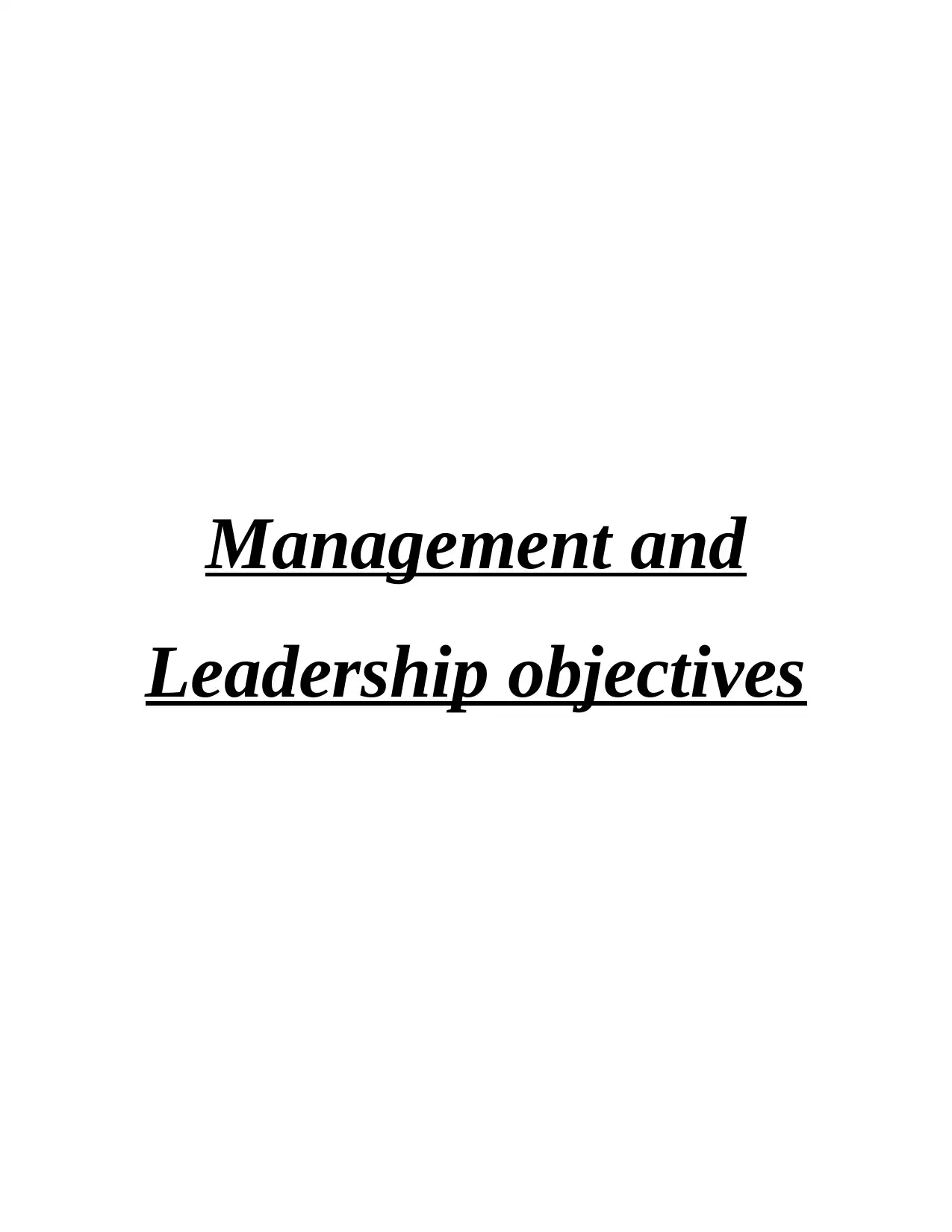
Management and
Leadership objectives
Leadership objectives
Paraphrase This Document
Need a fresh take? Get an instant paraphrase of this document with our AI Paraphraser
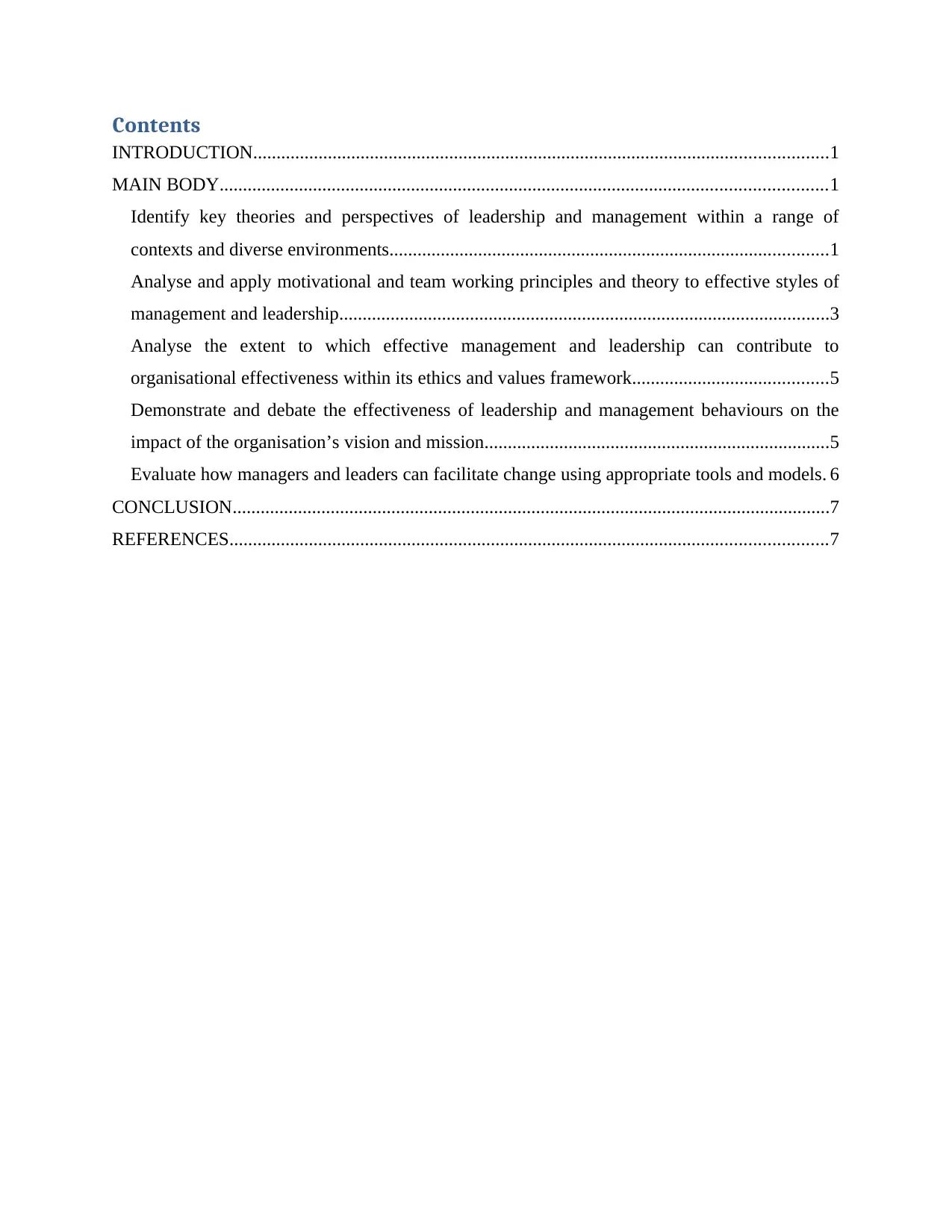
Contents
INTRODUCTION...........................................................................................................................1
MAIN BODY..................................................................................................................................1
Identify key theories and perspectives of leadership and management within a range of
contexts and diverse environments..............................................................................................1
Analyse and apply motivational and team working principles and theory to effective styles of
management and leadership.........................................................................................................3
Analyse the extent to which effective management and leadership can contribute to
organisational effectiveness within its ethics and values framework..........................................5
Demonstrate and debate the effectiveness of leadership and management behaviours on the
impact of the organisation’s vision and mission..........................................................................5
Evaluate how managers and leaders can facilitate change using appropriate tools and models. 6
CONCLUSION................................................................................................................................7
REFERENCES................................................................................................................................7
INTRODUCTION...........................................................................................................................1
MAIN BODY..................................................................................................................................1
Identify key theories and perspectives of leadership and management within a range of
contexts and diverse environments..............................................................................................1
Analyse and apply motivational and team working principles and theory to effective styles of
management and leadership.........................................................................................................3
Analyse the extent to which effective management and leadership can contribute to
organisational effectiveness within its ethics and values framework..........................................5
Demonstrate and debate the effectiveness of leadership and management behaviours on the
impact of the organisation’s vision and mission..........................................................................5
Evaluate how managers and leaders can facilitate change using appropriate tools and models. 6
CONCLUSION................................................................................................................................7
REFERENCES................................................................................................................................7
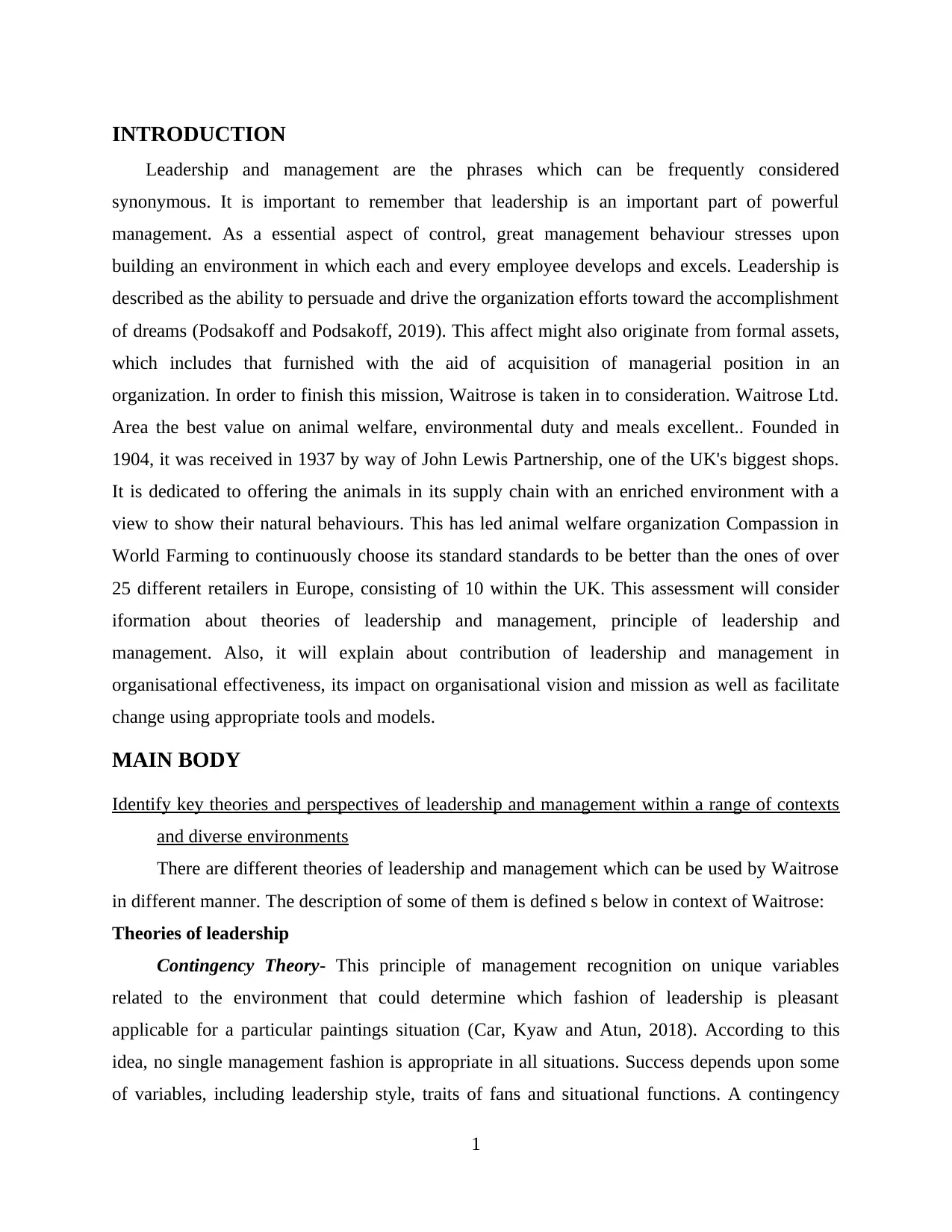
INTRODUCTION
Leadership and management are the phrases which can be frequently considered
synonymous. It is important to remember that leadership is an important part of powerful
management. As a essential aspect of control, great management behaviour stresses upon
building an environment in which each and every employee develops and excels. Leadership is
described as the ability to persuade and drive the organization efforts toward the accomplishment
of dreams (Podsakoff and Podsakoff, 2019). This affect might also originate from formal assets,
which includes that furnished with the aid of acquisition of managerial position in an
organization. In order to finish this mission, Waitrose is taken in to consideration. Waitrose Ltd.
Area the best value on animal welfare, environmental duty and meals excellent.. Founded in
1904, it was received in 1937 by way of John Lewis Partnership, one of the UK's biggest shops.
It is dedicated to offering the animals in its supply chain with an enriched environment with a
view to show their natural behaviours. This has led animal welfare organization Compassion in
World Farming to continuously choose its standard standards to be better than the ones of over
25 different retailers in Europe, consisting of 10 within the UK. This assessment will consider
iformation about theories of leadership and management, principle of leadership and
management. Also, it will explain about contribution of leadership and management in
organisational effectiveness, its impact on organisational vision and mission as well as facilitate
change using appropriate tools and models.
MAIN BODY
Identify key theories and perspectives of leadership and management within a range of contexts
and diverse environments
There are different theories of leadership and management which can be used by Waitrose
in different manner. The description of some of them is defined s below in context of Waitrose:
Theories of leadership
Contingency Theory- This principle of management recognition on unique variables
related to the environment that could determine which fashion of leadership is pleasant
applicable for a particular paintings situation (Car, Kyaw and Atun, 2018). According to this
idea, no single management fashion is appropriate in all situations. Success depends upon some
of variables, including leadership style, traits of fans and situational functions. A contingency
1
Leadership and management are the phrases which can be frequently considered
synonymous. It is important to remember that leadership is an important part of powerful
management. As a essential aspect of control, great management behaviour stresses upon
building an environment in which each and every employee develops and excels. Leadership is
described as the ability to persuade and drive the organization efforts toward the accomplishment
of dreams (Podsakoff and Podsakoff, 2019). This affect might also originate from formal assets,
which includes that furnished with the aid of acquisition of managerial position in an
organization. In order to finish this mission, Waitrose is taken in to consideration. Waitrose Ltd.
Area the best value on animal welfare, environmental duty and meals excellent.. Founded in
1904, it was received in 1937 by way of John Lewis Partnership, one of the UK's biggest shops.
It is dedicated to offering the animals in its supply chain with an enriched environment with a
view to show their natural behaviours. This has led animal welfare organization Compassion in
World Farming to continuously choose its standard standards to be better than the ones of over
25 different retailers in Europe, consisting of 10 within the UK. This assessment will consider
iformation about theories of leadership and management, principle of leadership and
management. Also, it will explain about contribution of leadership and management in
organisational effectiveness, its impact on organisational vision and mission as well as facilitate
change using appropriate tools and models.
MAIN BODY
Identify key theories and perspectives of leadership and management within a range of contexts
and diverse environments
There are different theories of leadership and management which can be used by Waitrose
in different manner. The description of some of them is defined s below in context of Waitrose:
Theories of leadership
Contingency Theory- This principle of management recognition on unique variables
related to the environment that could determine which fashion of leadership is pleasant
applicable for a particular paintings situation (Car, Kyaw and Atun, 2018). According to this
idea, no single management fashion is appropriate in all situations. Success depends upon some
of variables, including leadership style, traits of fans and situational functions. A contingency
1
⊘ This is a preview!⊘
Do you want full access?
Subscribe today to unlock all pages.

Trusted by 1+ million students worldwide
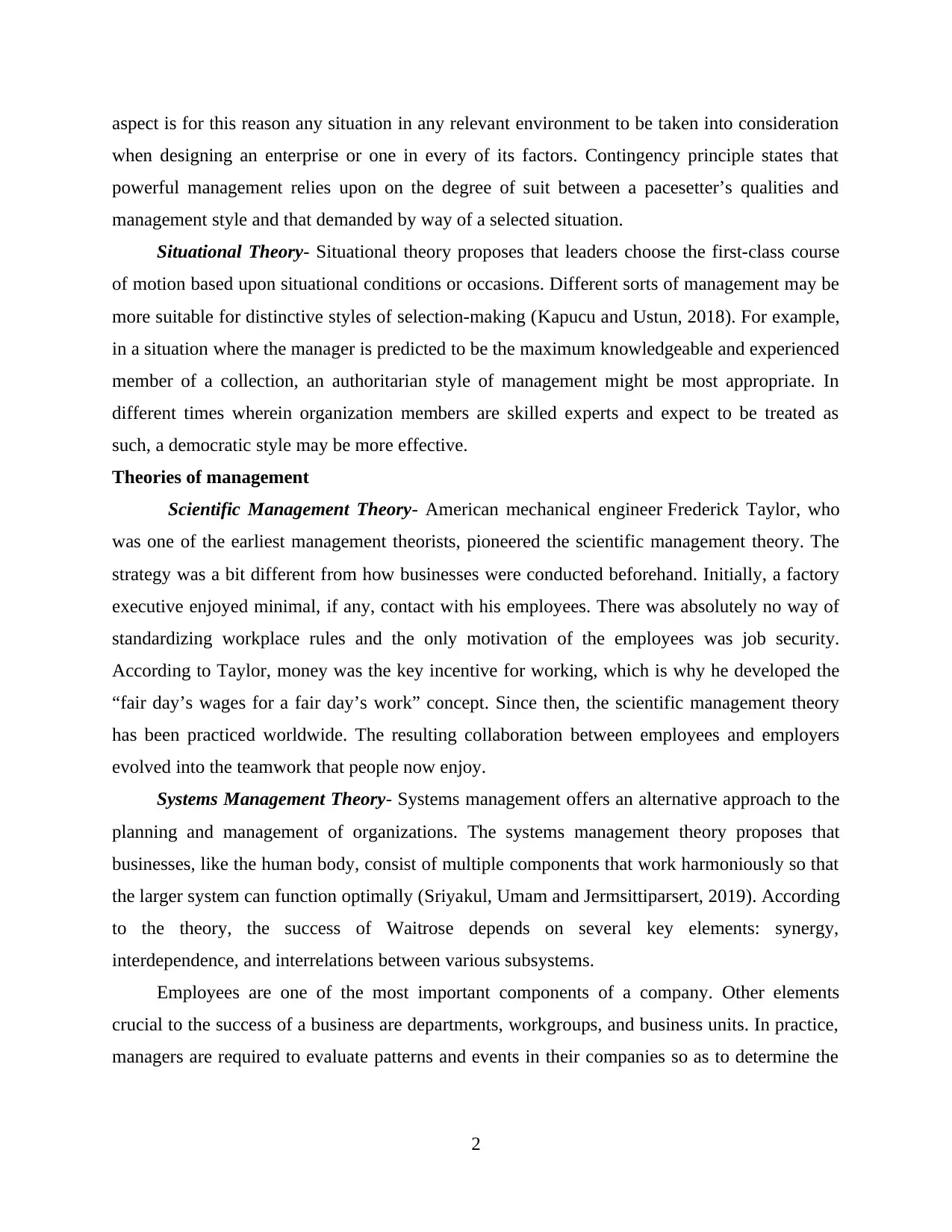
aspect is for this reason any situation in any relevant environment to be taken into consideration
when designing an enterprise or one in every of its factors. Contingency principle states that
powerful management relies upon on the degree of suit between a pacesetter’s qualities and
management style and that demanded by way of a selected situation.
Situational Theory- Situational theory proposes that leaders choose the first-class course
of motion based upon situational conditions or occasions. Different sorts of management may be
more suitable for distinctive styles of selection-making (Kapucu and Ustun, 2018). For example,
in a situation where the manager is predicted to be the maximum knowledgeable and experienced
member of a collection, an authoritarian style of management might be most appropriate. In
different times wherein organization members are skilled experts and expect to be treated as
such, a democratic style may be more effective.
Theories of management
Scientific Management Theory- American mechanical engineer Frederick Taylor, who
was one of the earliest management theorists, pioneered the scientific management theory. The
strategy was a bit different from how businesses were conducted beforehand. Initially, a factory
executive enjoyed minimal, if any, contact with his employees. There was absolutely no way of
standardizing workplace rules and the only motivation of the employees was job security.
According to Taylor, money was the key incentive for working, which is why he developed the
“fair day’s wages for a fair day’s work” concept. Since then, the scientific management theory
has been practiced worldwide. The resulting collaboration between employees and employers
evolved into the teamwork that people now enjoy.
Systems Management Theory- Systems management offers an alternative approach to the
planning and management of organizations. The systems management theory proposes that
businesses, like the human body, consist of multiple components that work harmoniously so that
the larger system can function optimally (Sriyakul, Umam and Jermsittiparsert, 2019). According
to the theory, the success of Waitrose depends on several key elements: synergy,
interdependence, and interrelations between various subsystems.
Employees are one of the most important components of a company. Other elements
crucial to the success of a business are departments, workgroups, and business units. In practice,
managers are required to evaluate patterns and events in their companies so as to determine the
2
when designing an enterprise or one in every of its factors. Contingency principle states that
powerful management relies upon on the degree of suit between a pacesetter’s qualities and
management style and that demanded by way of a selected situation.
Situational Theory- Situational theory proposes that leaders choose the first-class course
of motion based upon situational conditions or occasions. Different sorts of management may be
more suitable for distinctive styles of selection-making (Kapucu and Ustun, 2018). For example,
in a situation where the manager is predicted to be the maximum knowledgeable and experienced
member of a collection, an authoritarian style of management might be most appropriate. In
different times wherein organization members are skilled experts and expect to be treated as
such, a democratic style may be more effective.
Theories of management
Scientific Management Theory- American mechanical engineer Frederick Taylor, who
was one of the earliest management theorists, pioneered the scientific management theory. The
strategy was a bit different from how businesses were conducted beforehand. Initially, a factory
executive enjoyed minimal, if any, contact with his employees. There was absolutely no way of
standardizing workplace rules and the only motivation of the employees was job security.
According to Taylor, money was the key incentive for working, which is why he developed the
“fair day’s wages for a fair day’s work” concept. Since then, the scientific management theory
has been practiced worldwide. The resulting collaboration between employees and employers
evolved into the teamwork that people now enjoy.
Systems Management Theory- Systems management offers an alternative approach to the
planning and management of organizations. The systems management theory proposes that
businesses, like the human body, consist of multiple components that work harmoniously so that
the larger system can function optimally (Sriyakul, Umam and Jermsittiparsert, 2019). According
to the theory, the success of Waitrose depends on several key elements: synergy,
interdependence, and interrelations between various subsystems.
Employees are one of the most important components of a company. Other elements
crucial to the success of a business are departments, workgroups, and business units. In practice,
managers are required to evaluate patterns and events in their companies so as to determine the
2
Paraphrase This Document
Need a fresh take? Get an instant paraphrase of this document with our AI Paraphraser
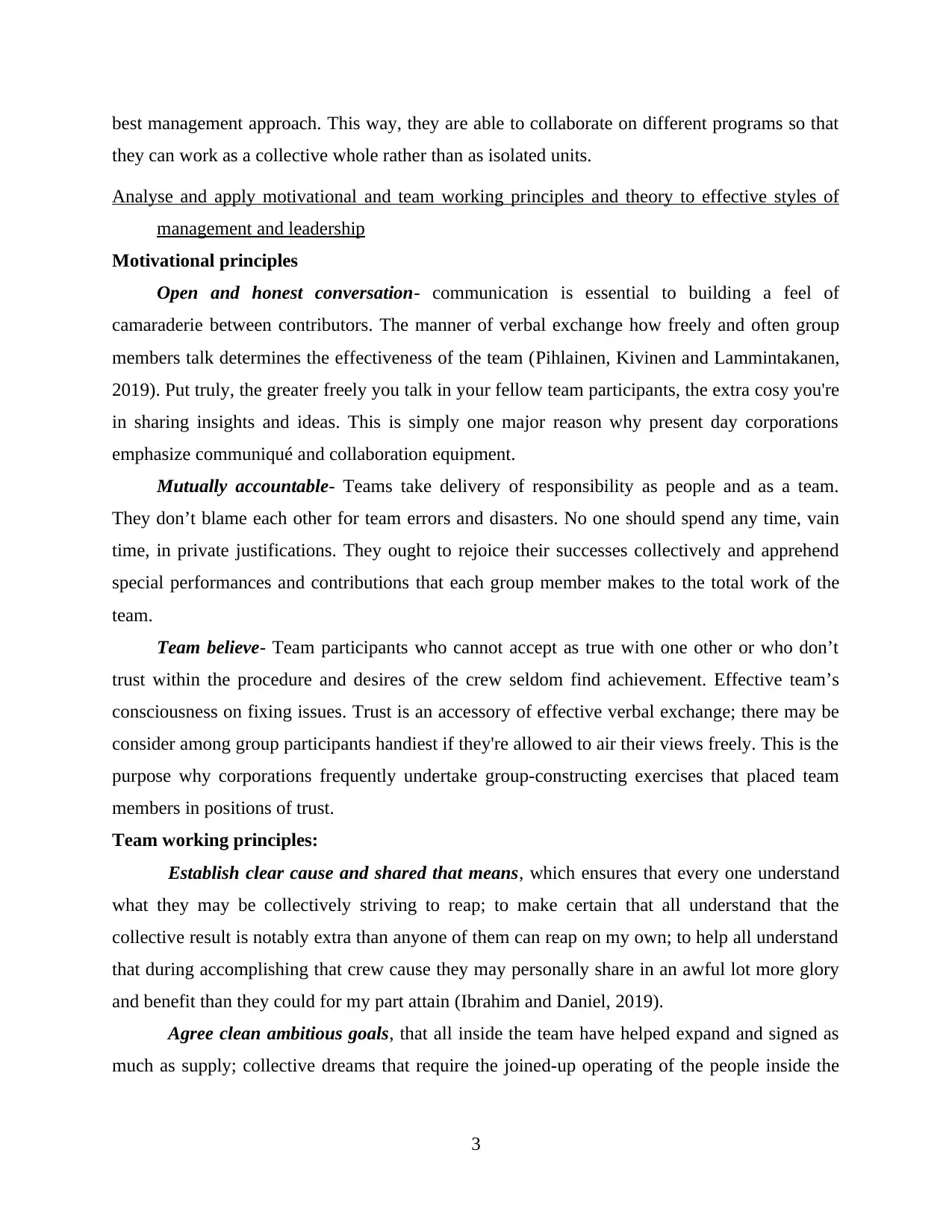
best management approach. This way, they are able to collaborate on different programs so that
they can work as a collective whole rather than as isolated units.
Analyse and apply motivational and team working principles and theory to effective styles of
management and leadership
Motivational principles
Open and honest conversation- communication is essential to building a feel of
camaraderie between contributors. The manner of verbal exchange how freely and often group
members talk determines the effectiveness of the team (Pihlainen, Kivinen and Lammintakanen,
2019). Put truly, the greater freely you talk in your fellow team participants, the extra cosy you're
in sharing insights and ideas. This is simply one major reason why present day corporations
emphasize communiqué and collaboration equipment.
Mutually accountable- Teams take delivery of responsibility as people and as a team.
They don’t blame each other for team errors and disasters. No one should spend any time, vain
time, in private justifications. They ought to rejoice their successes collectively and apprehend
special performances and contributions that each group member makes to the total work of the
team.
Team believe- Team participants who cannot accept as true with one other or who don’t
trust within the procedure and desires of the crew seldom find achievement. Effective team’s
consciousness on fixing issues. Trust is an accessory of effective verbal exchange; there may be
consider among group participants handiest if they're allowed to air their views freely. This is the
purpose why corporations frequently undertake group-constructing exercises that placed team
members in positions of trust.
Team working principles:
Establish clear cause and shared that means, which ensures that every one understand
what they may be collectively striving to reap; to make certain that all understand that the
collective result is notably extra than anyone of them can reap on my own; to help all understand
that during accomplishing that crew cause they may personally share in an awful lot more glory
and benefit than they could for my part attain (Ibrahim and Daniel, 2019).
Agree clean ambitious goals, that all inside the team have helped expand and signed as
much as supply; collective dreams that require the joined-up operating of the people inside the
3
they can work as a collective whole rather than as isolated units.
Analyse and apply motivational and team working principles and theory to effective styles of
management and leadership
Motivational principles
Open and honest conversation- communication is essential to building a feel of
camaraderie between contributors. The manner of verbal exchange how freely and often group
members talk determines the effectiveness of the team (Pihlainen, Kivinen and Lammintakanen,
2019). Put truly, the greater freely you talk in your fellow team participants, the extra cosy you're
in sharing insights and ideas. This is simply one major reason why present day corporations
emphasize communiqué and collaboration equipment.
Mutually accountable- Teams take delivery of responsibility as people and as a team.
They don’t blame each other for team errors and disasters. No one should spend any time, vain
time, in private justifications. They ought to rejoice their successes collectively and apprehend
special performances and contributions that each group member makes to the total work of the
team.
Team believe- Team participants who cannot accept as true with one other or who don’t
trust within the procedure and desires of the crew seldom find achievement. Effective team’s
consciousness on fixing issues. Trust is an accessory of effective verbal exchange; there may be
consider among group participants handiest if they're allowed to air their views freely. This is the
purpose why corporations frequently undertake group-constructing exercises that placed team
members in positions of trust.
Team working principles:
Establish clear cause and shared that means, which ensures that every one understand
what they may be collectively striving to reap; to make certain that all understand that the
collective result is notably extra than anyone of them can reap on my own; to help all understand
that during accomplishing that crew cause they may personally share in an awful lot more glory
and benefit than they could for my part attain (Ibrahim and Daniel, 2019).
Agree clean ambitious goals, that all inside the team have helped expand and signed as
much as supply; collective dreams that require the joined-up operating of the people inside the
3
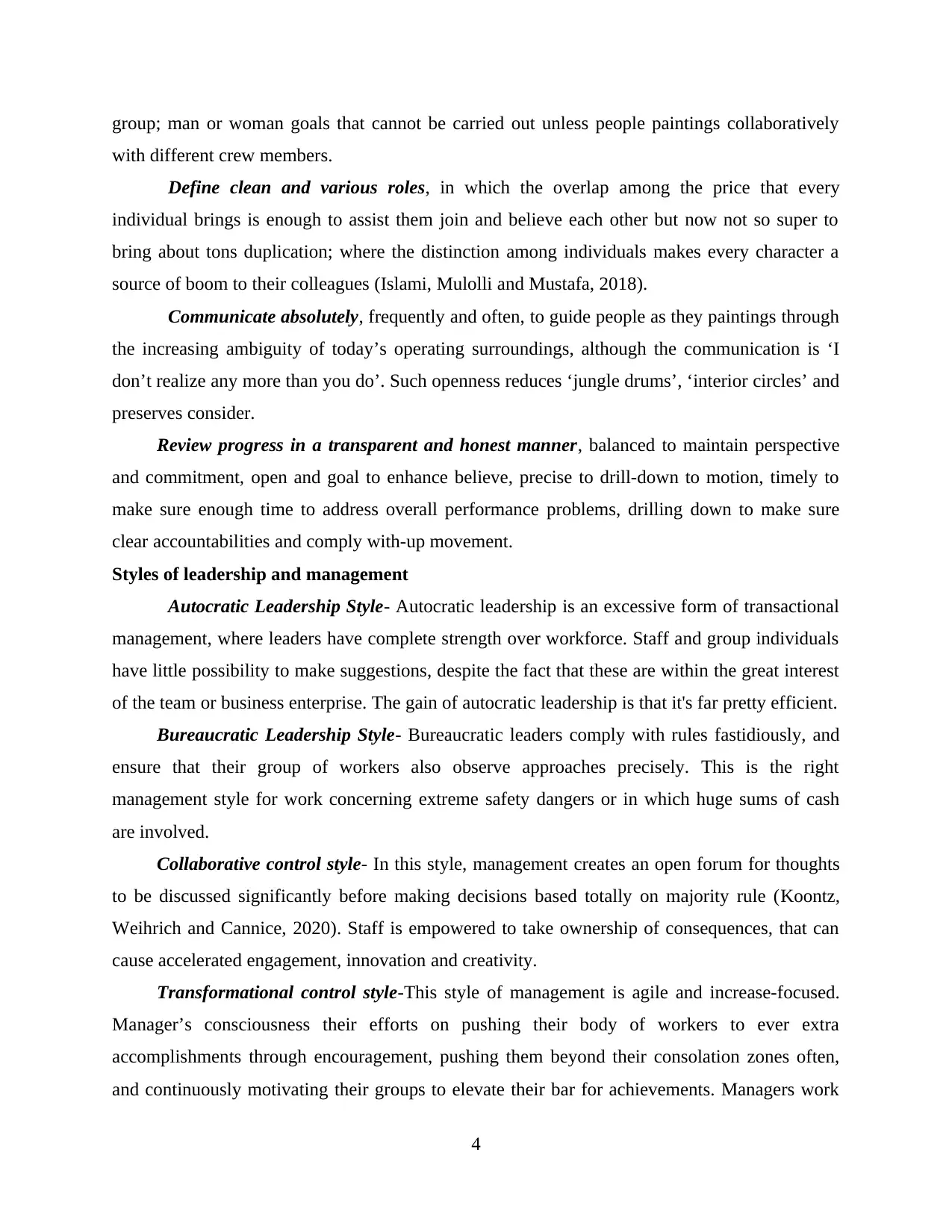
group; man or woman goals that cannot be carried out unless people paintings collaboratively
with different crew members.
Define clean and various roles, in which the overlap among the price that every
individual brings is enough to assist them join and believe each other but now not so super to
bring about tons duplication; where the distinction among individuals makes every character a
source of boom to their colleagues (Islami, Mulolli and Mustafa, 2018).
Communicate absolutely, frequently and often, to guide people as they paintings through
the increasing ambiguity of today’s operating surroundings, although the communication is ‘I
don’t realize any more than you do’. Such openness reduces ‘jungle drums’, ‘interior circles’ and
preserves consider.
Review progress in a transparent and honest manner, balanced to maintain perspective
and commitment, open and goal to enhance believe, precise to drill-down to motion, timely to
make sure enough time to address overall performance problems, drilling down to make sure
clear accountabilities and comply with-up movement.
Styles of leadership and management
Autocratic Leadership Style- Autocratic leadership is an excessive form of transactional
management, where leaders have complete strength over workforce. Staff and group individuals
have little possibility to make suggestions, despite the fact that these are within the great interest
of the team or business enterprise. The gain of autocratic leadership is that it's far pretty efficient.
Bureaucratic Leadership Style- Bureaucratic leaders comply with rules fastidiously, and
ensure that their group of workers also observe approaches precisely. This is the right
management style for work concerning extreme safety dangers or in which huge sums of cash
are involved.
Collaborative control style- In this style, management creates an open forum for thoughts
to be discussed significantly before making decisions based totally on majority rule (Koontz,
Weihrich and Cannice, 2020). Staff is empowered to take ownership of consequences, that can
cause accelerated engagement, innovation and creativity.
Transformational control style-This style of management is agile and increase-focused.
Manager’s consciousness their efforts on pushing their body of workers to ever extra
accomplishments through encouragement, pushing them beyond their consolation zones often,
and continuously motivating their groups to elevate their bar for achievements. Managers work
4
with different crew members.
Define clean and various roles, in which the overlap among the price that every
individual brings is enough to assist them join and believe each other but now not so super to
bring about tons duplication; where the distinction among individuals makes every character a
source of boom to their colleagues (Islami, Mulolli and Mustafa, 2018).
Communicate absolutely, frequently and often, to guide people as they paintings through
the increasing ambiguity of today’s operating surroundings, although the communication is ‘I
don’t realize any more than you do’. Such openness reduces ‘jungle drums’, ‘interior circles’ and
preserves consider.
Review progress in a transparent and honest manner, balanced to maintain perspective
and commitment, open and goal to enhance believe, precise to drill-down to motion, timely to
make sure enough time to address overall performance problems, drilling down to make sure
clear accountabilities and comply with-up movement.
Styles of leadership and management
Autocratic Leadership Style- Autocratic leadership is an excessive form of transactional
management, where leaders have complete strength over workforce. Staff and group individuals
have little possibility to make suggestions, despite the fact that these are within the great interest
of the team or business enterprise. The gain of autocratic leadership is that it's far pretty efficient.
Bureaucratic Leadership Style- Bureaucratic leaders comply with rules fastidiously, and
ensure that their group of workers also observe approaches precisely. This is the right
management style for work concerning extreme safety dangers or in which huge sums of cash
are involved.
Collaborative control style- In this style, management creates an open forum for thoughts
to be discussed significantly before making decisions based totally on majority rule (Koontz,
Weihrich and Cannice, 2020). Staff is empowered to take ownership of consequences, that can
cause accelerated engagement, innovation and creativity.
Transformational control style-This style of management is agile and increase-focused.
Manager’s consciousness their efforts on pushing their body of workers to ever extra
accomplishments through encouragement, pushing them beyond their consolation zones often,
and continuously motivating their groups to elevate their bar for achievements. Managers work
4
⊘ This is a preview!⊘
Do you want full access?
Subscribe today to unlock all pages.

Trusted by 1+ million students worldwide
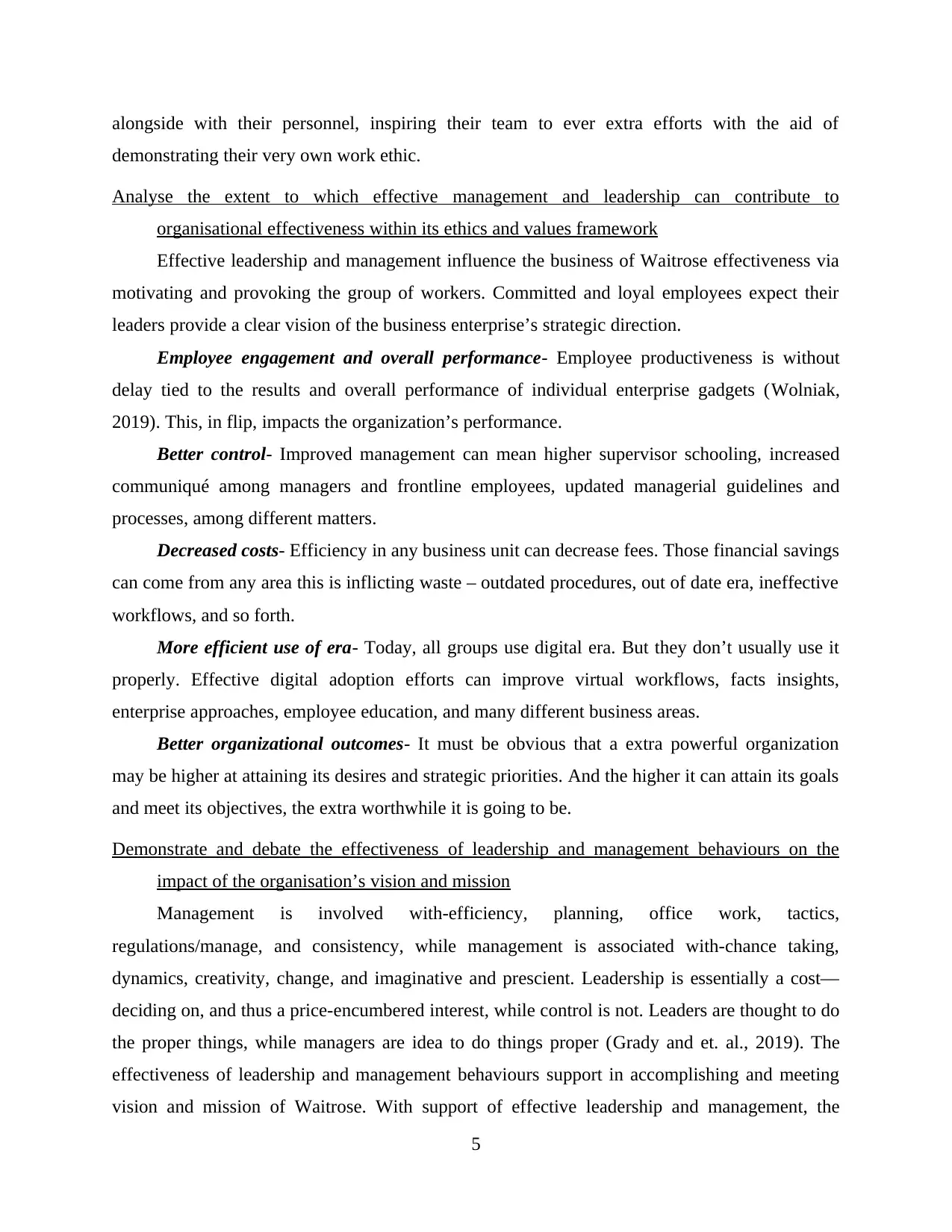
alongside with their personnel, inspiring their team to ever extra efforts with the aid of
demonstrating their very own work ethic.
Analyse the extent to which effective management and leadership can contribute to
organisational effectiveness within its ethics and values framework
Effective leadership and management influence the business of Waitrose effectiveness via
motivating and provoking the group of workers. Committed and loyal employees expect their
leaders provide a clear vision of the business enterprise’s strategic direction.
Employee engagement and overall performance- Employee productiveness is without
delay tied to the results and overall performance of individual enterprise gadgets (Wolniak,
2019). This, in flip, impacts the organization’s performance.
Better control- Improved management can mean higher supervisor schooling, increased
communiqué among managers and frontline employees, updated managerial guidelines and
processes, among different matters.
Decreased costs- Efficiency in any business unit can decrease fees. Those financial savings
can come from any area this is inflicting waste – outdated procedures, out of date era, ineffective
workflows, and so forth.
More efficient use of era- Today, all groups use digital era. But they don’t usually use it
properly. Effective digital adoption efforts can improve virtual workflows, facts insights,
enterprise approaches, employee education, and many different business areas.
Better organizational outcomes- It must be obvious that a extra powerful organization
may be higher at attaining its desires and strategic priorities. And the higher it can attain its goals
and meet its objectives, the extra worthwhile it is going to be.
Demonstrate and debate the effectiveness of leadership and management behaviours on the
impact of the organisation’s vision and mission
Management is involved with-efficiency, planning, office work, tactics,
regulations/manage, and consistency, while management is associated with-chance taking,
dynamics, creativity, change, and imaginative and prescient. Leadership is essentially a cost—
deciding on, and thus a price-encumbered interest, while control is not. Leaders are thought to do
the proper things, while managers are idea to do things proper (Grady and et. al., 2019). The
effectiveness of leadership and management behaviours support in accomplishing and meeting
vision and mission of Waitrose. With support of effective leadership and management, the
5
demonstrating their very own work ethic.
Analyse the extent to which effective management and leadership can contribute to
organisational effectiveness within its ethics and values framework
Effective leadership and management influence the business of Waitrose effectiveness via
motivating and provoking the group of workers. Committed and loyal employees expect their
leaders provide a clear vision of the business enterprise’s strategic direction.
Employee engagement and overall performance- Employee productiveness is without
delay tied to the results and overall performance of individual enterprise gadgets (Wolniak,
2019). This, in flip, impacts the organization’s performance.
Better control- Improved management can mean higher supervisor schooling, increased
communiqué among managers and frontline employees, updated managerial guidelines and
processes, among different matters.
Decreased costs- Efficiency in any business unit can decrease fees. Those financial savings
can come from any area this is inflicting waste – outdated procedures, out of date era, ineffective
workflows, and so forth.
More efficient use of era- Today, all groups use digital era. But they don’t usually use it
properly. Effective digital adoption efforts can improve virtual workflows, facts insights,
enterprise approaches, employee education, and many different business areas.
Better organizational outcomes- It must be obvious that a extra powerful organization
may be higher at attaining its desires and strategic priorities. And the higher it can attain its goals
and meet its objectives, the extra worthwhile it is going to be.
Demonstrate and debate the effectiveness of leadership and management behaviours on the
impact of the organisation’s vision and mission
Management is involved with-efficiency, planning, office work, tactics,
regulations/manage, and consistency, while management is associated with-chance taking,
dynamics, creativity, change, and imaginative and prescient. Leadership is essentially a cost—
deciding on, and thus a price-encumbered interest, while control is not. Leaders are thought to do
the proper things, while managers are idea to do things proper (Grady and et. al., 2019). The
effectiveness of leadership and management behaviours support in accomplishing and meeting
vision and mission of Waitrose. With support of effective leadership and management, the
5
Paraphrase This Document
Need a fresh take? Get an instant paraphrase of this document with our AI Paraphraser
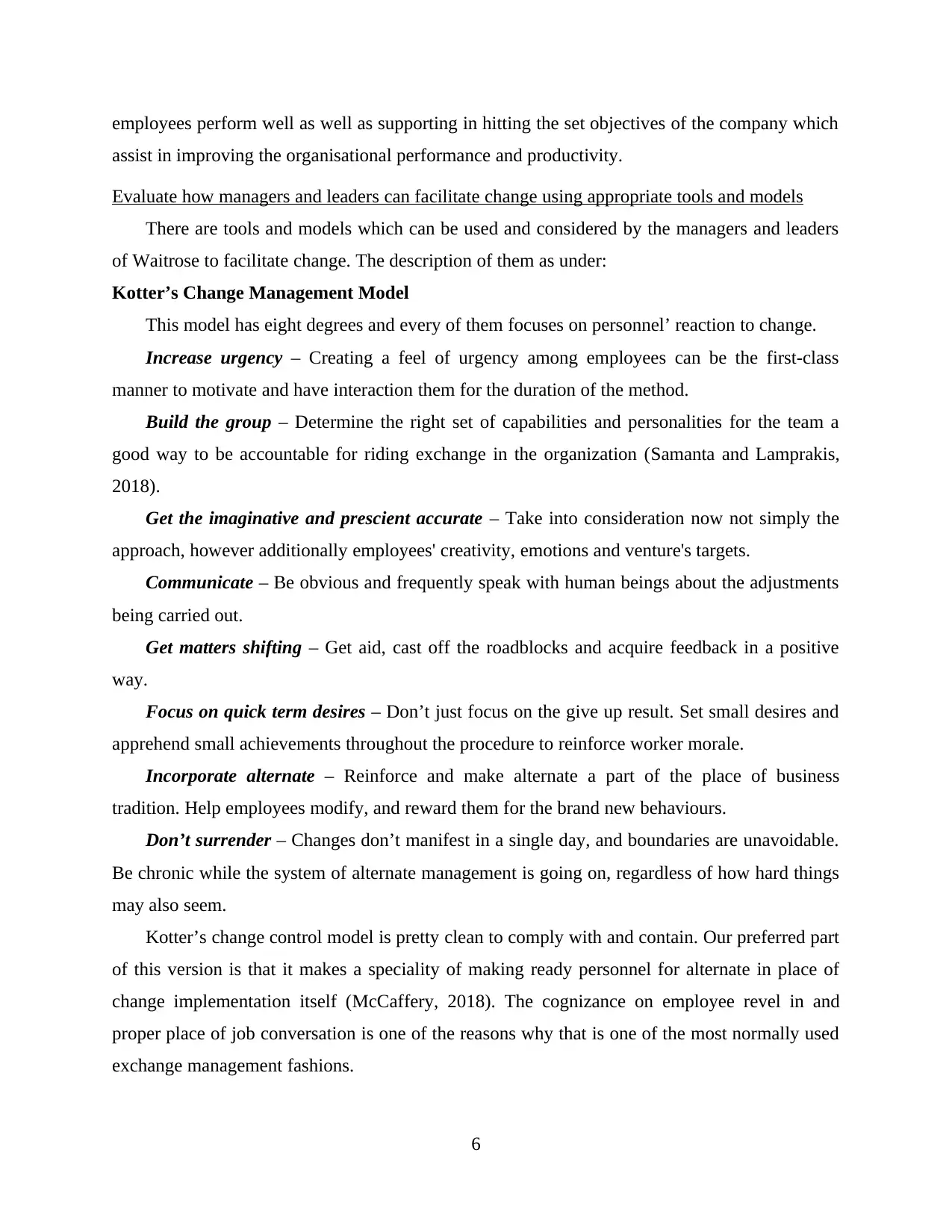
employees perform well as well as supporting in hitting the set objectives of the company which
assist in improving the organisational performance and productivity.
Evaluate how managers and leaders can facilitate change using appropriate tools and models
There are tools and models which can be used and considered by the managers and leaders
of Waitrose to facilitate change. The description of them as under:
Kotter’s Change Management Model
This model has eight degrees and every of them focuses on personnel’ reaction to change.
Increase urgency – Creating a feel of urgency among employees can be the first-class
manner to motivate and have interaction them for the duration of the method.
Build the group – Determine the right set of capabilities and personalities for the team a
good way to be accountable for riding exchange in the organization (Samanta and Lamprakis,
2018).
Get the imaginative and prescient accurate – Take into consideration now not simply the
approach, however additionally employees' creativity, emotions and venture's targets.
Communicate – Be obvious and frequently speak with human beings about the adjustments
being carried out.
Get matters shifting – Get aid, cast off the roadblocks and acquire feedback in a positive
way.
Focus on quick term desires – Don’t just focus on the give up result. Set small desires and
apprehend small achievements throughout the procedure to reinforce worker morale.
Incorporate alternate – Reinforce and make alternate a part of the place of business
tradition. Help employees modify, and reward them for the brand new behaviours.
Don’t surrender – Changes don’t manifest in a single day, and boundaries are unavoidable.
Be chronic while the system of alternate management is going on, regardless of how hard things
may also seem.
Kotter’s change control model is pretty clean to comply with and contain. Our preferred part
of this version is that it makes a speciality of making ready personnel for alternate in place of
change implementation itself (McCaffery, 2018). The cognizance on employee revel in and
proper place of job conversation is one of the reasons why that is one of the most normally used
exchange management fashions.
6
assist in improving the organisational performance and productivity.
Evaluate how managers and leaders can facilitate change using appropriate tools and models
There are tools and models which can be used and considered by the managers and leaders
of Waitrose to facilitate change. The description of them as under:
Kotter’s Change Management Model
This model has eight degrees and every of them focuses on personnel’ reaction to change.
Increase urgency – Creating a feel of urgency among employees can be the first-class
manner to motivate and have interaction them for the duration of the method.
Build the group – Determine the right set of capabilities and personalities for the team a
good way to be accountable for riding exchange in the organization (Samanta and Lamprakis,
2018).
Get the imaginative and prescient accurate – Take into consideration now not simply the
approach, however additionally employees' creativity, emotions and venture's targets.
Communicate – Be obvious and frequently speak with human beings about the adjustments
being carried out.
Get matters shifting – Get aid, cast off the roadblocks and acquire feedback in a positive
way.
Focus on quick term desires – Don’t just focus on the give up result. Set small desires and
apprehend small achievements throughout the procedure to reinforce worker morale.
Incorporate alternate – Reinforce and make alternate a part of the place of business
tradition. Help employees modify, and reward them for the brand new behaviours.
Don’t surrender – Changes don’t manifest in a single day, and boundaries are unavoidable.
Be chronic while the system of alternate management is going on, regardless of how hard things
may also seem.
Kotter’s change control model is pretty clean to comply with and contain. Our preferred part
of this version is that it makes a speciality of making ready personnel for alternate in place of
change implementation itself (McCaffery, 2018). The cognizance on employee revel in and
proper place of job conversation is one of the reasons why that is one of the most normally used
exchange management fashions.
6
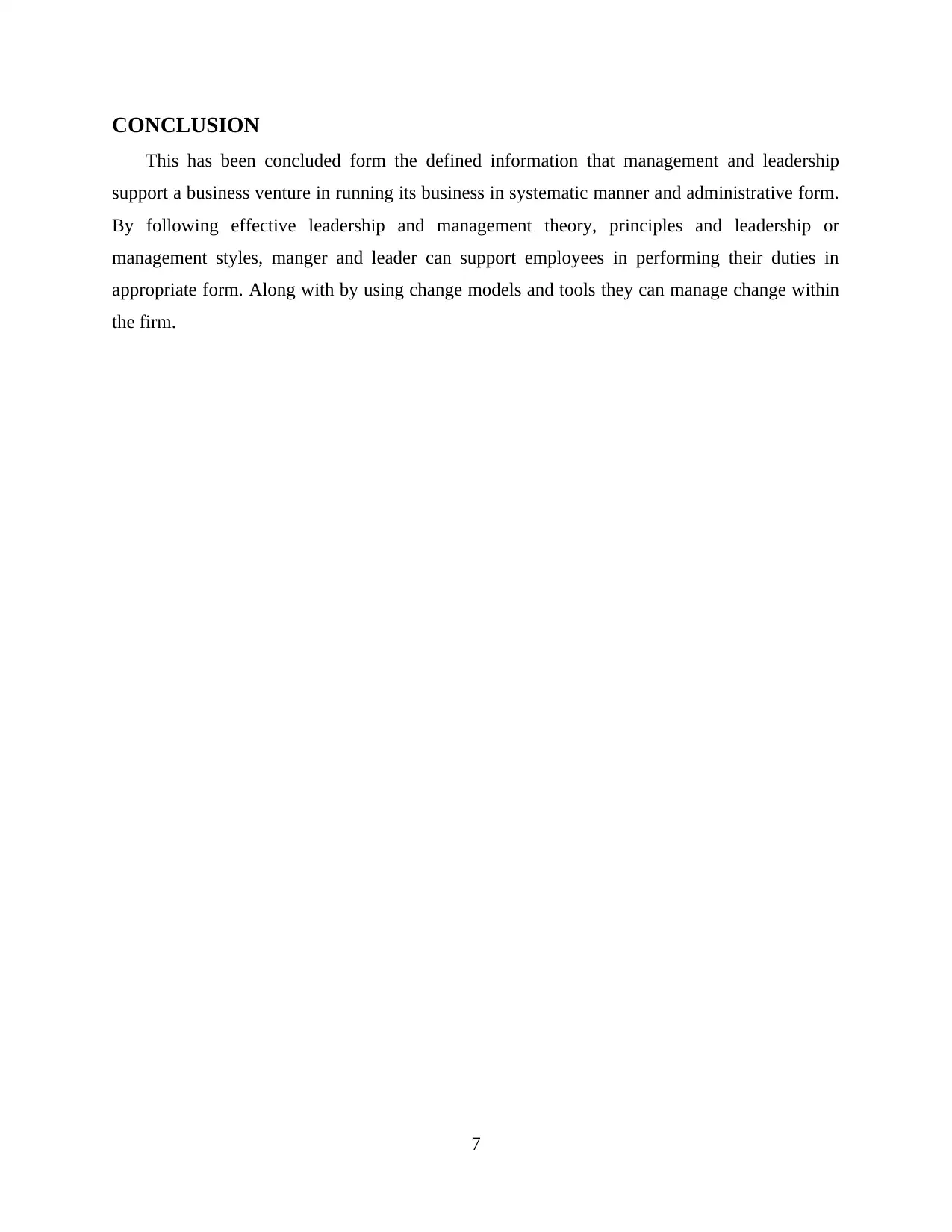
CONCLUSION
This has been concluded form the defined information that management and leadership
support a business venture in running its business in systematic manner and administrative form.
By following effective leadership and management theory, principles and leadership or
management styles, manger and leader can support employees in performing their duties in
appropriate form. Along with by using change models and tools they can manage change within
the firm.
7
This has been concluded form the defined information that management and leadership
support a business venture in running its business in systematic manner and administrative form.
By following effective leadership and management theory, principles and leadership or
management styles, manger and leader can support employees in performing their duties in
appropriate form. Along with by using change models and tools they can manage change within
the firm.
7
⊘ This is a preview!⊘
Do you want full access?
Subscribe today to unlock all pages.

Trusted by 1+ million students worldwide
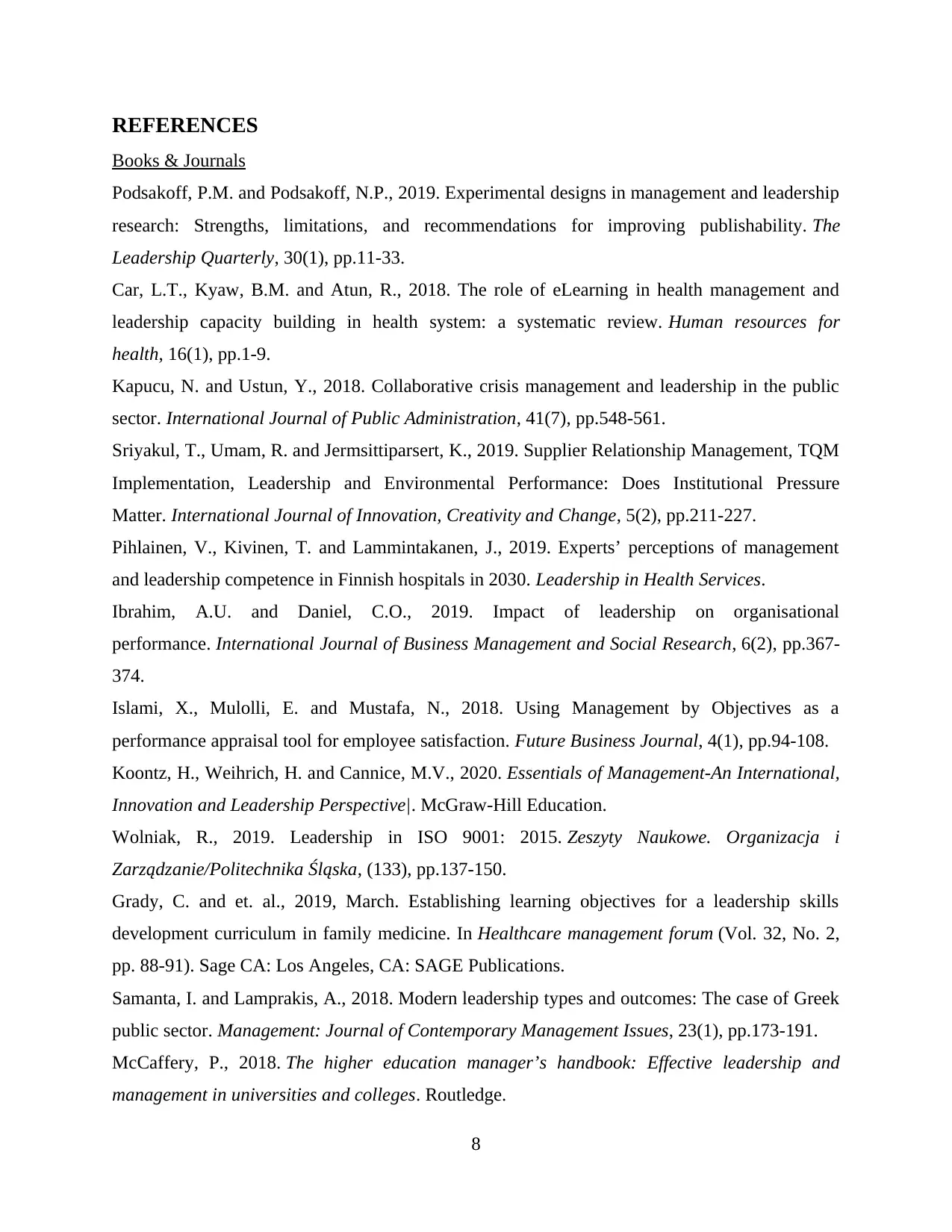
REFERENCES
Books & Journals
Podsakoff, P.M. and Podsakoff, N.P., 2019. Experimental designs in management and leadership
research: Strengths, limitations, and recommendations for improving publishability. The
Leadership Quarterly, 30(1), pp.11-33.
Car, L.T., Kyaw, B.M. and Atun, R., 2018. The role of eLearning in health management and
leadership capacity building in health system: a systematic review. Human resources for
health, 16(1), pp.1-9.
Kapucu, N. and Ustun, Y., 2018. Collaborative crisis management and leadership in the public
sector. International Journal of Public Administration, 41(7), pp.548-561.
Sriyakul, T., Umam, R. and Jermsittiparsert, K., 2019. Supplier Relationship Management, TQM
Implementation, Leadership and Environmental Performance: Does Institutional Pressure
Matter. International Journal of Innovation, Creativity and Change, 5(2), pp.211-227.
Pihlainen, V., Kivinen, T. and Lammintakanen, J., 2019. Experts’ perceptions of management
and leadership competence in Finnish hospitals in 2030. Leadership in Health Services.
Ibrahim, A.U. and Daniel, C.O., 2019. Impact of leadership on organisational
performance. International Journal of Business Management and Social Research, 6(2), pp.367-
374.
Islami, X., Mulolli, E. and Mustafa, N., 2018. Using Management by Objectives as a
performance appraisal tool for employee satisfaction. Future Business Journal, 4(1), pp.94-108.
Koontz, H., Weihrich, H. and Cannice, M.V., 2020. Essentials of Management-An International,
Innovation and Leadership Perspective|. McGraw-Hill Education.
Wolniak, R., 2019. Leadership in ISO 9001: 2015. Zeszyty Naukowe. Organizacja i
Zarządzanie/Politechnika Śląska, (133), pp.137-150.
Grady, C. and et. al., 2019, March. Establishing learning objectives for a leadership skills
development curriculum in family medicine. In Healthcare management forum (Vol. 32, No. 2,
pp. 88-91). Sage CA: Los Angeles, CA: SAGE Publications.
Samanta, I. and Lamprakis, A., 2018. Modern leadership types and outcomes: The case of Greek
public sector. Management: Journal of Contemporary Management Issues, 23(1), pp.173-191.
McCaffery, P., 2018. The higher education manager’s handbook: Effective leadership and
management in universities and colleges. Routledge.
8
Books & Journals
Podsakoff, P.M. and Podsakoff, N.P., 2019. Experimental designs in management and leadership
research: Strengths, limitations, and recommendations for improving publishability. The
Leadership Quarterly, 30(1), pp.11-33.
Car, L.T., Kyaw, B.M. and Atun, R., 2018. The role of eLearning in health management and
leadership capacity building in health system: a systematic review. Human resources for
health, 16(1), pp.1-9.
Kapucu, N. and Ustun, Y., 2018. Collaborative crisis management and leadership in the public
sector. International Journal of Public Administration, 41(7), pp.548-561.
Sriyakul, T., Umam, R. and Jermsittiparsert, K., 2019. Supplier Relationship Management, TQM
Implementation, Leadership and Environmental Performance: Does Institutional Pressure
Matter. International Journal of Innovation, Creativity and Change, 5(2), pp.211-227.
Pihlainen, V., Kivinen, T. and Lammintakanen, J., 2019. Experts’ perceptions of management
and leadership competence in Finnish hospitals in 2030. Leadership in Health Services.
Ibrahim, A.U. and Daniel, C.O., 2019. Impact of leadership on organisational
performance. International Journal of Business Management and Social Research, 6(2), pp.367-
374.
Islami, X., Mulolli, E. and Mustafa, N., 2018. Using Management by Objectives as a
performance appraisal tool for employee satisfaction. Future Business Journal, 4(1), pp.94-108.
Koontz, H., Weihrich, H. and Cannice, M.V., 2020. Essentials of Management-An International,
Innovation and Leadership Perspective|. McGraw-Hill Education.
Wolniak, R., 2019. Leadership in ISO 9001: 2015. Zeszyty Naukowe. Organizacja i
Zarządzanie/Politechnika Śląska, (133), pp.137-150.
Grady, C. and et. al., 2019, March. Establishing learning objectives for a leadership skills
development curriculum in family medicine. In Healthcare management forum (Vol. 32, No. 2,
pp. 88-91). Sage CA: Los Angeles, CA: SAGE Publications.
Samanta, I. and Lamprakis, A., 2018. Modern leadership types and outcomes: The case of Greek
public sector. Management: Journal of Contemporary Management Issues, 23(1), pp.173-191.
McCaffery, P., 2018. The higher education manager’s handbook: Effective leadership and
management in universities and colleges. Routledge.
8
Paraphrase This Document
Need a fresh take? Get an instant paraphrase of this document with our AI Paraphraser
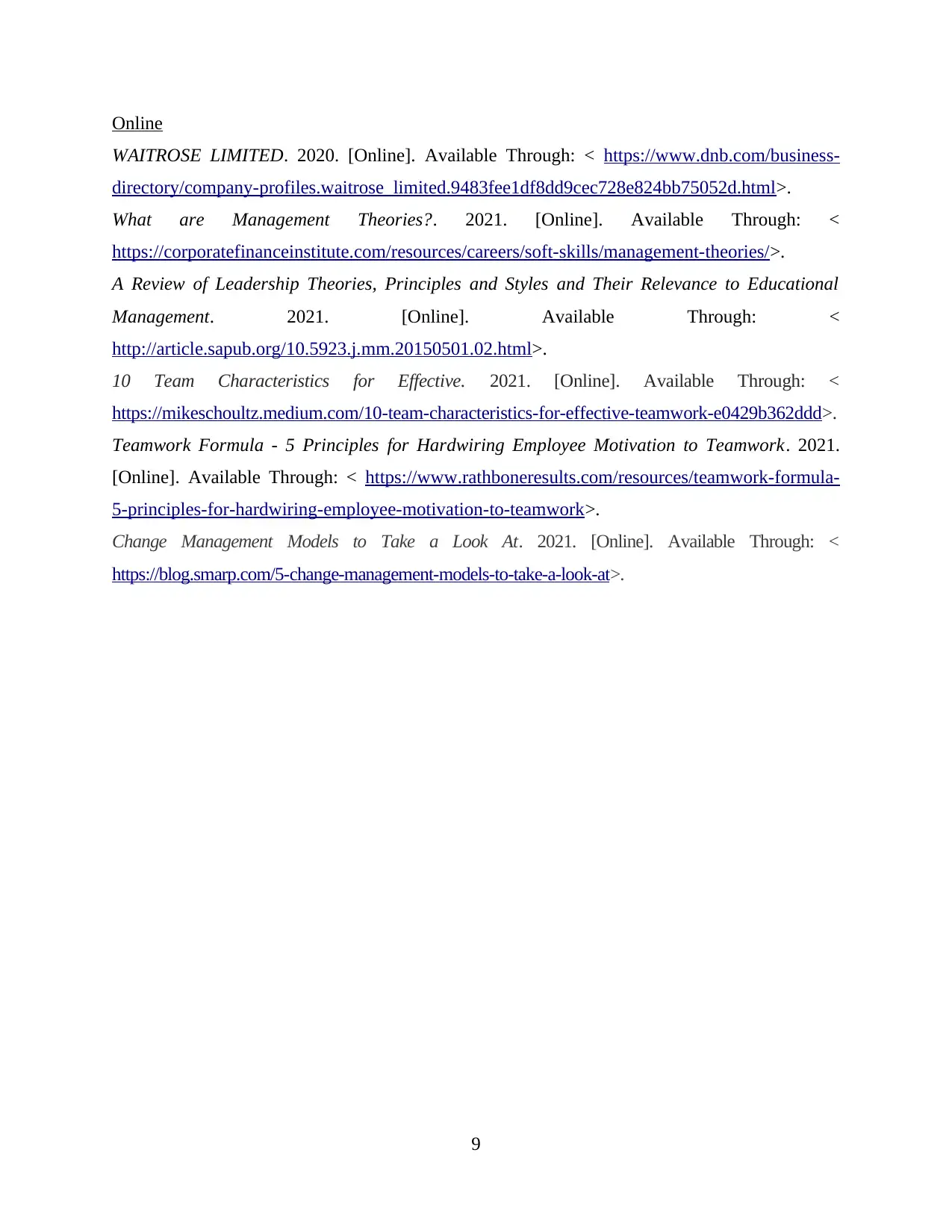
Online
WAITROSE LIMITED. 2020. [Online]. Available Through: < https://www.dnb.com/business-
directory/company-profiles.waitrose_limited.9483fee1df8dd9cec728e824bb75052d.html>.
What are Management Theories?. 2021. [Online]. Available Through: <
https://corporatefinanceinstitute.com/resources/careers/soft-skills/management-theories/>.
A Review of Leadership Theories, Principles and Styles and Their Relevance to Educational
Management. 2021. [Online]. Available Through: <
http://article.sapub.org/10.5923.j.mm.20150501.02.html>.
10 Team Characteristics for Effective. 2021. [Online]. Available Through: <
https://mikeschoultz.medium.com/10-team-characteristics-for-effective-teamwork-e0429b362ddd>.
Teamwork Formula - 5 Principles for Hardwiring Employee Motivation to Teamwork. 2021.
[Online]. Available Through: < https://www.rathboneresults.com/resources/teamwork-formula-
5-principles-for-hardwiring-employee-motivation-to-teamwork>.
Change Management Models to Take a Look At. 2021. [Online]. Available Through: <
https://blog.smarp.com/5-change-management-models-to-take-a-look-at>.
9
WAITROSE LIMITED. 2020. [Online]. Available Through: < https://www.dnb.com/business-
directory/company-profiles.waitrose_limited.9483fee1df8dd9cec728e824bb75052d.html>.
What are Management Theories?. 2021. [Online]. Available Through: <
https://corporatefinanceinstitute.com/resources/careers/soft-skills/management-theories/>.
A Review of Leadership Theories, Principles and Styles and Their Relevance to Educational
Management. 2021. [Online]. Available Through: <
http://article.sapub.org/10.5923.j.mm.20150501.02.html>.
10 Team Characteristics for Effective. 2021. [Online]. Available Through: <
https://mikeschoultz.medium.com/10-team-characteristics-for-effective-teamwork-e0429b362ddd>.
Teamwork Formula - 5 Principles for Hardwiring Employee Motivation to Teamwork. 2021.
[Online]. Available Through: < https://www.rathboneresults.com/resources/teamwork-formula-
5-principles-for-hardwiring-employee-motivation-to-teamwork>.
Change Management Models to Take a Look At. 2021. [Online]. Available Through: <
https://blog.smarp.com/5-change-management-models-to-take-a-look-at>.
9
1 out of 11
Related Documents
Your All-in-One AI-Powered Toolkit for Academic Success.
+13062052269
info@desklib.com
Available 24*7 on WhatsApp / Email
![[object Object]](/_next/static/media/star-bottom.7253800d.svg)
Unlock your academic potential
Copyright © 2020–2025 A2Z Services. All Rights Reserved. Developed and managed by ZUCOL.




